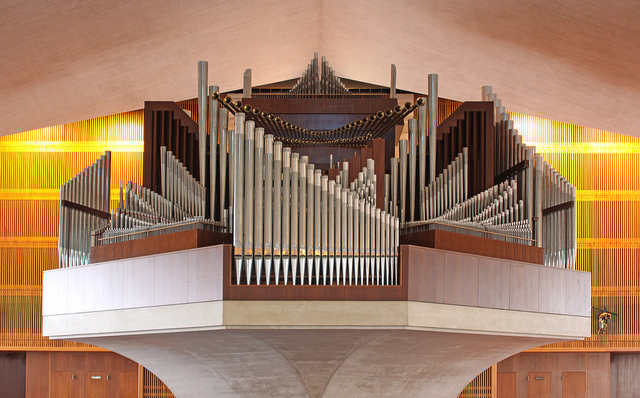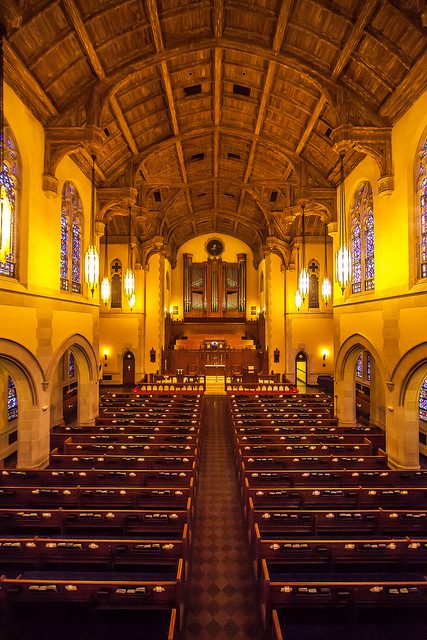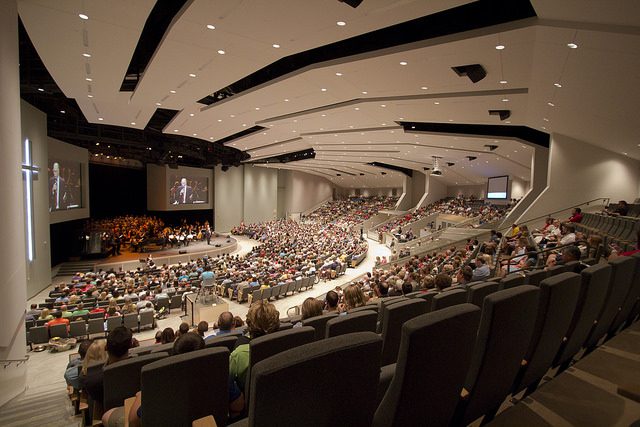Nearly every day, I see a link to an article or post in my Facebook and Twitter feeds bemoaning the lack of singing in many churches today. While I think many of them make some good points about why we’re no longer singing people, few of them offer insight into fixing the problem. And it’s true. Congregational singing is dead (with a few exceptions), and we have killed it. It’s a problem that with all the music we’re subjected to in our lives (and often in our churches), we just don’t know how to actually sing anymore.
But here are a few things that could help reverse the damage.
1. Teach. Teach your people. Teach them why we sing. Teach them why we sing the songs we sing. Teach them how to sing as well as they possibly can. Teach them the best songs. Christians must understand their history as a singing people and the biblical mandate to sing together, or they won’t understand why they should sing in the first place.
2. Dust off the organ console.
There’s a reason the organ was brought back into the church during the Protestant Reformation. It wasn’t because it was cool. It wasn’t that it helped people feel “connected.” It was because the organ is uniquely able to support sustained, hearty congregational singing. It’s not that I hate guitars. In fact, I listen to guitar-driven popular music all the time. But even when amplified, the guitar just isn’t up to the task of leading and supporting a large group.
3. Bring the choir back. With a choir, you have a significant part of the church committed to serving as an example and encouragement for the rest of the congregation. And it’s much easier for a hesitant singer to join in with a sizable, confident, prepared group than a soloist or smaller ensemble.
4. Make it obvious that your congregational singing isn’t supposed to be a performance. Is it really any wonder that congregational singing has declined as the church has increasingly mimicked the musical entertainment of our culture? I mean, compare these two videos.
Which is supposed to be congregational singing? Really, I can’t tell.
When the congregation’s role in singing is shifted from primary to dispensable, as if they’re singing along at a rock concert or with the radio, there’s no compelling reason to sing out. Even our vocabulary has changed. Instead of chancel or platform, we have a stage. I even read something recently recommending the creation of a “worship producer” position. Want to offer christianized pop entertainment? Keep it up. Want to revive group singing in your church? Don’t make it into such a spectacle. Turn up the lights, stand still, and be serious about the task at hand.
5. Get rid of the lead singer. While we’re on the subject of performances, there is absolutely nothing that kills group singing like a soloist crooning into a microphone. If it is absolutely necessary to have an individual leading by themselves, make sure it’s someone who can model a warm, pure, neutral tone, without affected vocals or ad-libbing. If possible, eliminate the amplification, or at least have them step back from the microphone after bringing the congregation in, so that the congregation learns to take initiative and not simply defer to the leader.
6. Don’t sing so much. In the days of historic liturgy, songs, hymns, and sung responses were spread out throughout the service or mass. It’s common for contemporary churches to have 30+ minutes of uninterrupted music. Though your performers are probably having the time of their life, many congregants will lose focus and tire out at some point.
7. Sing all the time. On the other hand, make singing, and not just musical entertainment, a part of your church life outside Sunday services. Sing your faith in Sunday School. Sing at church functions. Encourage families to sing at home. Make singing part of the culture.
8. Build a resonant sanctuary. These days, you can walk into many churches and not be certain you’re in a sacred space. Is it a theater? Sporting venue? Conference center? Abandoned Wal-Mart? Who knows? And though padded seats, carpeting, and stadium seating are all the rage in church architecture, they deaden live music so much that it’s hard to even hear yourself, much less those around you, much less the musical leadership. Building spaces for beautiful music isn’t vain or an unnecessary expense, it promotes the congregation’s ability to follow the New Testament admonition to be a singing people.
So choose something like this:
9. Encourage and support the arts in the community. Take a group to the symphony. Offer the use of your sanctuary for school and community performances. Though it may not mean immediate results for your congregation, it will promote music-making in your community. Let’s face it, with the proliferation of recorded music in our society, we have gone from being music-makers to music consumers, and often lazy, indiscriminate ones, at that. Congregational singing in worship has slipped because the church has followed the society down that path. Do what you can to reverse it.
10. Bring the kids back into corporate worship. Honestly, there’s no way congregational singing can survive even another generation unless we start with the youngest worshipers. Speaking as a former elementary music teacher, though abilities vary, every child can and should learn how to sing. There are lots of ways to do this. Bring back the graded choir program, and allow them to sing regularly. Begin a music academy. Host a music camp during the summer. And although we’re not making music like today like we did in previous generations, musical arts still thrive in many areas through school systems. That means your kids might be your greatest musical resource. Make sure they learn how to plug that learning into the local church before they graduate and are no longer involved in music making on that level.
11. Use hymnals. Or at least make printed music available. Though many people don’t read music, there are probably some in your church that do, and giving them printed music will empower them to lead out in congregational singing. And over time, anyone can learn to at least follow the melodic direction and rhythm. Even though they seem to be obligatory these days, using the projection screen puts you at a distinct disadvantage.
12. Make the music worth singing. The primary job of church music is to support the liturgy. Plan accordingly. Don’t sing just for the sake of singing, but make sure each piece of music fulfills a specific function. Choose songs with good, singable melodies that fit the theology of the poetry. Choose solid texts that sing your faith, not just how you feel about your faith. Forsake the musical fast food of the recording industry, and replace it with something that will last, something that will do some good in the long run.
13. Stop doing the same songs over and over and over. I read a blog post today in which a worship leader said he would do the same song three times in a month! When I was a kid in the mid 90s, my church sang “Shout to the Lord” in something like 15 straight services. I know because I was at each one, and by the last, nobody was singing besides the worship team. Instead of teaching new hymns and songs by repeating them ad nauseam, have a congregational rehearsal before the service begins. Place stronger voices strategically in the congregation. Do anything besides singing the same thing over and over and over.
Not all are immediately practical solutions for every congregation. Congregational singing wasn’t destroyed overnight, and it won’t be relearned overnight. But in time, implementing these ideas would begin to build a singing culture in our congregations once again. It will take a concerted effort. It will take patience. It will take making changes that aren’t popular with everyone or that might not immediately resonate with the culture around us.
That’s okay.
After all, we sing a different song.
Photos:
Forsaken Fotos, creative commons 2.0
Identify With Research, creative commons 2.0
Jason John Paul Haskins, creative commons 2.0
Thomas Hawk, creative commons 2.0
Appleton Alliance Church, creative commons 2.0
Jennifer Morrow, creative commons 2.0




















